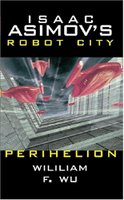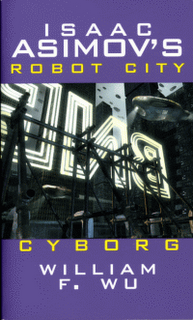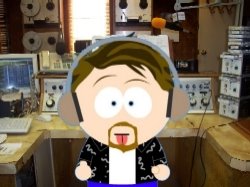"Isaac Asimov's Robot City Book 6: Perihelion" by William F. Wu. (published by Ace Books 1988)

Well sadly I've come to the end of the series of books that is "Robot City." It has been a great endeavor with some ups and downs in both reading of the series and the adventures of "David/Derec" and "Katherine/Ariel." Before I go too much further allow me to recap the idea behind these books.
Isaac Asimov's Robot City is a series of novels written by various authors and loosely connected to Isaac Asimov's Robot Series. It takes place between The Robots of Dawn and Robots and Empire. The novels were written in response to a writing challenge issued by Asimov to write a series involving the Three Laws of Robotics, which brought about a collaboration of several talented authors.
The books in this series are:
1. Odyssey by Michael P. Kube-McDowell (1987)
2. Suspicion by Mike McQuay (1987)
3. Cyborg by William F. Wu (1987)
4. Prodigy by Arthur Byron Cover (1988)
5. Refuge by Rob Chilson (1988)
6. Perihelion by William F. Wu (1988)
One thing this series introduces is the concept of aliens. In Asimov's universe there were no other intelligent lifeforms other than human and robot. In the later books by Asimov he explained that this could be because the robots were sent ahead of humanity to terraform planets and thus destroying alien life forms. So maybe some aliens could have "survived." In my humble opinion I think Asimov simply wanted to explore humanity through robots and their interaction with humans and just left out the aliens.
This book is the final book in the series and the second in the series by writer William F. Wu. In Perihelion, Derec and Ariel have returned to Robot City from Earth to find Dr. Avery (the creator of Robot City) and find out why he has "infected" Derec with Chemfets, molecule sized robots that are taking over Derec's Body.
Upon arrival the team of Derec, Ariel, Wolruff (the caninoid alien) and Mandlebrot (the hybrid robot created by Derec) find that Robot City has pretty much covered the entire planet and the robots are all finishing up tasks and instructed to reprogram to "migration programming." While trying to solve this puzzle of migration programming and find Dr. Avery the team must avoid Hunter robots that wish to capture them.
As they get closer to Avery, Derec's infection of Chemfets leaves him immobilized. The team is joined by Jeff Leong, the man who was turned into a cyborg in book 3. Jeff is back to help them off the planet thinking they were still stranded as when he last left them. As it turns out Jeff had met Dr. Avery when Dr. Avery sought Jeff's fathers assistance in creating Robot City.
The books climax is one that not only wraps up the entire series and solves all the mysteries, but also leaves space for the series to continue. In fact the last page of the book says, "Robot city continues in book #7." Sadly no book 7 was ever written. Actually that's not quite true...Asimov did the same with this series in another series called "Robots & Aliens." That series is said to continue where this one left off. Guess I'll be looking for that series next.
All in all the experiment was a success and I think all the authors captured the spirit of Asimov's robots. Maybe a standard should be set here.
Labels: book review, books, Isaac Asimov, robot city, robotics, robots, Science-Fiction, william f. wu
posted by Gil T. @ 2:07 PM


Isaac Asimov's Robot City Book 3 "Cyborg" by William F. Wu

In science fiction, the Three Laws of Robotics are a set of three rules written by Isaac Asimov, which almost all positronic robots (designated by their Asimov created positronic brains) appearing in his fiction must obey. Introduced in his 1942 short story "Runaround", although foreshadowed in a few earlier stories, the Laws state the following:
- A robot may not injure a human being or, through inaction, allow a human being to come to harm.
- A robot must obey orders given it by human beings except where such orders would conflict with the First Law.
- A robot must protect its own existence as long as such protection does not conflict with the First or Second Law.
Isaac Asimov created these laws as more or less a challenge to himself for writing his novels. Later, Asimov added the Zeroth Law: "A robot may not harm humanity, or, by inaction, allow humanity to come to harm;" the rest of the laws are modified sequentially to acknowledge this. He created murder mysteries in space using the 3 laws and the Detective Elijah Bailey. Bailey would receive help from R. Daneel Olivaw, a human appearing robot. Many science fiction writers have used the ideas of Asimov's robots, but no other author could directly state 3 three laws. Many sci-fi writers used the ideas of the laws but never stated them as Asimov did. Even the positronic brain was copied in the series "Star Trek: The Next Generation." Commander Data had a positronic brain. Asimov was honored to have many sci-fi writers copy the ideas but the laws were his and he did not allow this. Not until the Robot City series of books. This series of 6 books was a challenge to 4 different Sci-Fi writers to write stories based solely on the laws and Asimov's universe.
Isaac Asimov's Robot City is a series of novels written by various authors and loosely connected to Isaac Asimov's Robot Series. It takes place between The Robots of Dawn and Robots and Empire. The novels were written in response to a writing challenge issued by Asimov to write a series involving the Three Laws of Robotics, which brought about a collaboration of several talented authors.
The books in this series are:
- Odyssey by Michael P. Kube-McDowell (1987)
- Suspicion by Mike McQuay (1987)
- Cyborg by William F. Wu (1987)
- Prodigy by Arthur Byron Cover (1988)
- Refuge by Rob Chilson (1988)
- Perihelion by William F. Wu (1988)
So the experiment continues, I have just completed reading book 3 in the series "Cyborg" by William F. Wu, and while it was a good continuation of the series, at times it seemed very juvenile. It's as though the writer were writing for teenagers rather than for a middle age guy like me. The dialog at times did seem stunted and not very in depth. At times in the book I looked as though it did help move the story along but also at times it seemed awkward.
The reason that it may have helped move the story is that in this entry into the "Robot City" series we are introduced to a new character: Jeff Leong, an 18 year old off to college. Jeff's ship crashes on the planet "Robot City" and in order to save his life (1st law) the robots transplant his brain into a robot body while putting his body into cryostasis (frozen) until they can repair it. This creates the reason for the book's title "Cyborg," a cybernetic organism, human and robot. At the beginning of the book is a very interesting essay on the concept of cyborgs by Isaac Asimov, which prepares you for the ideals sought in this story.
In this episod Derec and Katherine have stopped the planet's "self-destruction" by solving a murder (see book 2) and are trying to find a way off the planet. Their only known way off is to get their hands on the Key to Perihelion, which is what brought them to this strange planet in the first place. They have discovered that the Key has been destroyed but the robots destroyed it to manufacture duplicate copies But why? On top of trying to capture the runaway cyborg, Jeff, they have this mystery to solve. Using only the 3 laws Derec & Katherine capture Jeff.
Also during this book we find that Katherine's real name is Ariel, she's got some terminal illness and is a runaway from the planet Aurora. So now Derec, who still doesn't have his memory back, has to help Arial.
The two are reunited with Alpha and Wolruf. Alpha a robot Derec built to help him escape some unfriendly aliens and Wolruf an alien dog like being that also helped Derec escape.
Almost soap opera like, and in spite of the "juvenile" writing in this one, i'm off to read book 4 "Prodigy"
Post Script:
The author of this book, William F. Wu wrote to me and cleared up the "juvenile" aspect:
Hi, Mr. Wilson,
I just happened across your observations about the Robot City series, including the first one I wrote, No. 3. You noted, correctly, that it seemed to be written for young people.
I realize you posted those comments more than a year ago, but anyway, I thought I'd give you some more information.
Contractually, the book was a juvenile, or "Young Adult," in current publishing parlance. All of the writers in the series were initially told that it would a Young Adult series, and labeled so. Later, the publisher decided not to label the series Young Adult, but just as Science Fiction. By this time, all the books had been written and edited. A related problem was that we all -- all of the writers in the series knew each other, at least a little bit -- had a different idea of what Young Adult meant. In any case, our contracts had a long list of forbidden subjects and terminology. The targeted marketing group in the contract was twelve-year-old boys.
In reading them myself, I saw that we definitely responded to the Young Adult concept in different ways, and I think most of us came to feel the uneven nature of the series was not a good thing. I think the first, by Michael P. Kube-McDowell, probably had the least amount of Young Adult feel, but that's just my opinion.
In any case, I thought I'd offer this information to you. Feel free to post or ignore any of this, as you wish.
Wishing you the best,
Bill
(William F. Wu)
http://www.williamfwu.comLabels: book review, books, cyborg, Isaac Asimov, robot city, robotics, robots, Science-Fiction, william f. wu
posted by Gil T. @ 9:10 PM


 Well sadly I've come to the end of the series of books that is "Robot City." It has been a great endeavor with some ups and downs in both reading of the series and the adventures of "David/Derec" and "Katherine/Ariel." Before I go too much further allow me to recap the idea behind these books.
Well sadly I've come to the end of the series of books that is "Robot City." It has been a great endeavor with some ups and downs in both reading of the series and the adventures of "David/Derec" and "Katherine/Ariel." Before I go too much further allow me to recap the idea behind these books. In science fiction, the Three Laws of Robotics are a set of three rules written by Isaac Asimov, which almost all positronic robots (designated by their Asimov created positronic brains) appearing in his fiction must obey. Introduced in his 1942 short story "Runaround", although foreshadowed in a few earlier stories, the Laws state the following:
In science fiction, the Three Laws of Robotics are a set of three rules written by Isaac Asimov, which almost all positronic robots (designated by their Asimov created positronic brains) appearing in his fiction must obey. Introduced in his 1942 short story "Runaround", although foreshadowed in a few earlier stories, the Laws state the following:





























